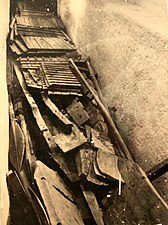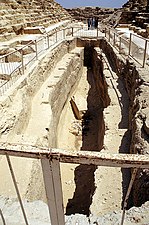| Khufu ship | |
|---|---|
 The reconstructed "solar barge" of Khufu The reconstructed "solar barge" of Khufu | |
| Type | Solar barque |
| Material | Lebanon cedar |
| Long | 43.4 metres (142 ft) |
| Width | 5.9 metres (19 ft) |
| Created | c. 2500 BC |
| Discovered | 1954 Giza pyramid complex |
| Discovered by | Kamal el-Mallakh |
| Present location | Grand Egyptian Museum |
| Culture | Ancient Egypt |
The Khufu ship is an intact full-size solar barque from ancient Egypt. It was sealed into a pit alongside the Great Pyramid of pharaoh Khufu around 2500 BC, during the Fourth Dynasty of the ancient Egyptian Old Kingdom. Like other buried Ancient Egyptian ships, it was part of the extensive grave goods intended for use in the afterlife. The Khufu ship is one of the oldest, largest, best preserved vessels from antiquity. It is 43.4 metres (142 ft) long, 5.9 metres (19 ft) wide, and 1.78 meters (5.83 ft) deep, and is the world's oldest intact ship. It has been described as "a masterpiece of woodcraft" that could sail today if put into a lake or a river.
The ship was preserved in the Giza Solar boat museum, but was moved to the Grand Egyptian Museum in August 2021.
History
Function
The history and function of the ship is not precisely known. It is of the type known as a "solar barge", a ritual vessel believed by ancient Egyptians to carry the resurrected king across the heavens with the sun god Ra. However, it bears some signs of having been used in water, and it is possible that the ship was either a funerary "barge" used to carry the king's embalmed body from Memphis to Giza, or even that Khufu himself used it as a "pilgrimage ship" to visit holy places and that it was then buried for him to use in the afterlife. It contained no bodies, unlike northern European ship burials.
Discovery and description

The ship was one of two rediscovered in 1954 by Kamal el-Mallakh—undisturbed since it was sealed into a pit carved out of the Giza bedrock. It was built largely of Lebanon cedar wood, bending the planks in the "shell-first" construction technique, using unpegged tenons of Christ's thorn. The ship was built with a flat bottom composed of several planks, but no actual keel, with the planks and frames lashed together with Halfah grass, and has been reconstructed from 1,224 pieces which had been laid in a logical, disassembled order in the pit beside the pyramid.
It measures 43.4 meters (142 ft) long and 5.9 metres (19 ft) wide. It was thus identified as the world's oldest intact ship and has been described as "a masterpiece of woodcraft" that could sail today if put into a lake, or a river. However, the vessel may not have been designed for sailing, as there is no rigging, or for rowing, as there is no room. Its discovery was described as one of the greatest Ancient Egyptian discoveries in Zahi Hawass's documentary Egypt's Ten Greatest Discoveries.
Reconstruction
It took years for the boat to be reassembled, primarily by the Egyptian Department of Antiquities' chief restorer, Ahmed Youssef Moustafa. Before reconstructing the boat, Moustafa had to gain enough experience on Ancient Egyptian boatbuilding. He studied the reliefs carved on walls and tombs as well as many of the small wooden models of ships and boats found in tombs. Moustafa visited the Nile boatyards of Old Cairo and Maadi and went to Alexandria, where wooden river boats were still being made. He hoped that modern Egyptian shipwrights had retained shipbuilding methods that would suggest how Ancient Egyptians built their ships. Then he investigated the work of shipwrights who built in a different tradition.
Exhibition
The Khufu ship was put on public display in a specially built museum at the Giza pyramid complex in 1982; the museum was a small modern facility resting alongside the Great Pyramid. The first floor of the museum took the visitor through visuals, photographs, and writings on the process of excavating and restoring the boat. The ditch where the main boat was found was incorporated into the museum's ground floor design. To see the restored boat, the visitor ascended a staircase leading to the second floor. Floor-to-ceiling windows allowed for much sunlight, and the wooden walkway took the visitor around the boat where the visitor could get a closer view of its impressive size.
In August 2021, the ship was relocated to the Grand Egyptian Museum.
Gallery
-
 The Khufu ship shortly after its discovery
The Khufu ship shortly after its discovery
-
 The boat pit in which the Khufu ship was discovered, now inside the Solar Boat Museum
The boat pit in which the Khufu ship was discovered, now inside the Solar Boat Museum
-
 Original rope discovered with the Khufu ship
Original rope discovered with the Khufu ship
-
 The Khufu ship in the Solar boat museum
The Khufu ship in the Solar boat museum
-
 Solar boat pit, Giza Plateau, Egypt
Solar boat pit, Giza Plateau, Egypt
-
One of the boat pits on the east side of the Great Pyramid
See also
References
- ^ Jenkins, Nancy (1980). The Boat Beneath the Pyramid (PDF). ISBN 978-0030570612.
- "Egypt Excavates Ancient King's 4,500-Year-Old Ship". Fox News. Associated Press. 23 June 2011. Archived from the original on 2011-06-26. Retrieved 25 June 2011.
Archaeologists have begun excavating a 4,500-year-old wooden boat found next to the Great Pyramid of Giza, one of Egypt's main tourist attractions, Egypt's top antiquities official said Thursday.
- Bram; Me-Bar (2024). "The production method of the Khufu-1 sheer planks: carving or bending?". Wood Material Science & Engineering.
- Clark, Liesl; Tyson, Peter. "Explore Ancient Egypt". Nova. PBS. Retrieved 28 December 2012.
- "The Royal Ships of Egyptian Pharaohs". Cwo.com. Retrieved 2019-01-17.
- Jenkins, Nancy (May 26, 1954). "The Smell of Time". Saudi Aramco World. Aramco Services Company. Archived from the original on 2012-05-07. Retrieved 2012-12-27.
- Sarman, Danee (March 1, 2010). "Did Pharaohs Get Seasick?: Khufu Boat Museum: Giza, Egypt". MuseumChick.com. Archived from the original on April 14, 2010. Retrieved 2012-12-27.
- "A team from the Grand Egyptian Museum succeeded in the first trial run conducted to test the vehicles that will be used in the transferring the first Khufu Solar Boat from its current location".
- "In pictures: Egypt pharaoh's 'solar boat' moved to Giza museum". BBC News. 2021-08-07. Retrieved 2021-08-07.
Further reading
- Nancy Jenkins (1980). The boat beneath the pyramid: King Cheops' royal ship ISBN 0-03-057061-1
- Paul Lipke (1984). The royal ship of Cheops: a retrospective account of the discovery, restoration and reconstruction. Based on interviews with Hag Ahmed Youssef Moustafa. Oxford: B.A.R., ISBN 0-86054-293-9
- Björn Landström (1970). Ships of the Pharaohs: 4000 Years of Egyptian Shipbuilding. Doubleday & Company, Inc., LCCN 73-133207
- Weitzman, David (2020 ). Pharaoh's Boat Reissued by Purple House Press, ISBN 9781948959148
External links
- The Smell of Time
- The Solar Barque, Nova Online
- Web archive backup: Ships of the World: An Historical Encyclopedia – "Cheops ship"
- The Giza Mapping Project
- A Visitors Perspective of the Khufu Boat Museum
- Khufu ship free high resolution images
29°58′41″N 31°08′04″E / 29.97806°N 31.13444°E / 29.97806; 31.13444
| Longest wooden ships | |
|---|---|
| Ancient ships | |
| Medieval and modern oar-powered ships | |
| Wind-powered only |
|
| Steam-powered | |
| Immobile | |
| Other | |
| Surviving ships launched before 1919 | |
|---|---|
| operational preserved | |
| Pre-1800 |
|
| 1800–1879 |
|
| 1880–1899 |
|
| 1900–1907 |
|
| 1908–1914 |
|
| World War I |
|
